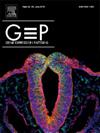Pre-gestational restraint stress affects reproductive outcomes in adult rats by modulating ovarian and uterine function
IF 1.1
4区 生物学
Q4 DEVELOPMENTAL BIOLOGY
引用次数: 0
Abstract
The impact of gestational stress on reproductive outcomes is well-established, but the effects of pre-gestational stress remain inconclusive. Using female Wistar rats, we demonstrated that pre-gestational stress negatively affects fertility and pregnancy outcomes. The rats were subjected to restraint stress (RS) for 15 days, with 3 h of stress each day, before mating. The RS group exhibited higher levels of corticosterone and prolactin, along with lower levels of adrenocorticotropic hormone (ACTH), indicating a successful stress model. Stressed rats showed reduced fertility and fecundity indices, longer conception times, and decreased levels of ovarian steroids, such as progesterone, testosterone, and estradiol. Additionally, the ovaries of the RS group had fewer antral follicles and more ovarian cysts. Elevated protein levels of cytochrome P450 side-chain cleavage enzyme (CYP11A1) and aromatase (CYP19A1), along with decreased levels of 17β-hydroxysteroid dehydrogenase (17β-HSD), indicating impaired ovarian steroidogenesis in stress exposed rats. In the RS group, there was a significant increase in proteins associated with folliculogenesis, specifically octamer-binding transcription factor 4 (OCT 4) and growth differentiation factor 9 (GDF 9). Additionally, proteins linked to ovulation, such as the prolactin receptor (PRLR), peroxisome proliferator-activated receptor-γ (PPAR-γ), and cyclooxygenase 2 (COX 2), were elevated. The increased levels of PRLR, progesterone receptor (PR), androgen receptor (AR), and estrogen receptor (ER) combined with heightened oxidative stress in the uteri of the RS group, suggest a potential disruption in uterine function. Overall, this research indicates that pre-gestational stress can significantly impact reproductive health by altering gonadotrophin and ovarian steroid dynamics in the female reproductive tract.

妊娠前约束应激通过调节卵巢和子宫功能影响成年大鼠的生殖结局
妊娠应激对生殖结果的影响是公认的,但妊娠前应激的影响仍不确定。使用雌性Wistar大鼠,我们证明了妊娠前应激对生育能力和妊娠结局有负面影响。交配前给大鼠施加限制性应激(RS) 15 d,每天应激3 h。RS组表现出较高水平的皮质酮和催乳素,以及较低水平的促肾上腺皮质激素(ACTH),表明应激模型成功。应激大鼠的生育能力和繁殖力指数下降,受胎时间延长,卵巢类固醇激素(如黄体酮、睾酮和雌二醇)水平下降。此外,RS组卵巢有更少的窦卵泡和更多的卵巢囊肿。细胞色素P450侧链切割酶(CYP11A1)和芳香化酶(CYP19A1)蛋白水平升高,17β-羟基类固醇脱氢酶(17β-HSD)水平降低,表明应激暴露大鼠卵巢类固醇生成受损。在RS组中,与卵泡发生相关的蛋白质显著增加,特别是八聚体结合转录因子4 (OCT 4)和生长分化因子9 (GDF 9)。此外,与排卵相关的蛋白质,如催乳素受体(PRLR)、过氧化物酶体增殖物激活受体-γ (PPAR-γ)和环氧化酶2 (COX 2)均升高。RS组子宫内PRLR、孕酮受体(PR)、雄激素受体(AR)和雌激素受体(ER)水平升高,并伴有氧化应激升高,提示子宫功能可能受到破坏。总体而言,本研究表明,妊娠前应激可通过改变女性生殖道的促性腺激素和卵巢类固醇动态而显著影响生殖健康。
本文章由计算机程序翻译,如有差异,请以英文原文为准。
求助全文
约1分钟内获得全文
求助全文
来源期刊

Gene Expression Patterns
生物-发育生物学
CiteScore
2.30
自引率
0.00%
发文量
42
审稿时长
35 days
期刊介绍:
Gene Expression Patterns is devoted to the rapid publication of high quality studies of gene expression in development. Studies using cell culture are also suitable if clearly relevant to development, e.g., analysis of key regulatory genes or of gene sets in the maintenance or differentiation of stem cells. Key areas of interest include:
-In-situ studies such as expression patterns of important or interesting genes at all levels, including transcription and protein expression
-Temporal studies of large gene sets during development
-Transgenic studies to study cell lineage in tissue formation
 求助内容:
求助内容: 应助结果提醒方式:
应助结果提醒方式:


